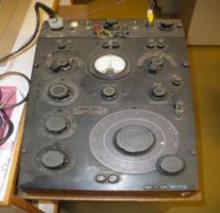The Impedance Bridge, sometimes called as “universal bridge” measures Resistance (R), Capacitance (C) and its Dissipation factor (D), Inductance (L) and its Quality factor (Q) separately by audio frequency such as 1 kHz. “Impedance” is a genetic term of R, C and L. The basic principle of an impedance bridge is similar to the principle of a balance comparing unknowns with their built-in standards. The balance is established by adjusting the balancing arm manually. Since the accuracy of the balance (hence the bridge) depends on a stability of built-in standards, the accuracy lasts long. Various types of bridges have been used for the maintenance of national impedance standards until modern sophisticated equipments have developed.
The concepts behind these bridges are very simple. The bridges are used in conjunction with a signal generator and detector. If you look closely at the upper left and right connectors on each box, you will see that they are labeled Generator (or Gen) and Detector (or Det).


